#like the ‘magazine’ comics where morbius appeared
Text
very interested in how marvel + dc are both experimenting with the webtoon format (infinite scroll/minimal paneling + simpler art style) and how what is published in that format is not traditional superhero stories but things that might be more in line generically with what you would find in a webtoon (for example, making a whole comic dedicated to romance, which is a very popular webtoon genre but not a popular genre for the comics you’d find in an american comic book store)
it’s very different from the early days of infinite comics, where the paneling was often very important and it moved from panel to panel with powerpoint animations. and it’s always interesting to see how marvel and dc respond to other comic forms and try to capitalize on what is popular. especially right now when it seems like the traditional comic book industry is perpetually on the edge of dying.
#m.txt#as an artifact of our present historical moment it’s really interesting!#like. do i like it? not really. is it absolutely fascinating? you bet!#the reason i don’t like it also has less to do with the format specifically and more to do with the capitalism of it all#stop stifling creative expression in your artists by denying them living wages and benefits!!#also I’m thinking about the young adult graphic novels dc has been putting out recently#I am not Starfire Harley Quinn: Breaking Glass Stiefvater’s Swamp Thing#that’s a different medium/format from traditional comics too#and it reminds me a lot of when Marvel dabbled in publishing manga#or how DC has Ngozi writing for them now#or how OGNs were all the rage in the 80s/90s#it’s like the 20 page floppy has arguably been the same for decades (at least since the 60s)#but it’s come into contact with so many other forms of comic over the years#that it’s impossible for it not to be changed#like the ‘magazine’ comics where morbius appeared#or the spider man newspaper comic#idk what my point is anymore except that ‘comics’ as a word encompasses so much#and when we use it to talk about floppies distributed by diamond we sometimes forget#not only that the term encompasses so much but that even the big 2 are engaged in an ongoing negotiation with all other types of comics
13 notes
·
View notes
Text
youtube
WORLD PREMIER: LES GHOULS - locked away in the vault of Roy Thomas, released for the first time in 65 years for your viewing pleasure!
Les Ghouls is a 12½-minute, mostly black-&-white film made circa 1958 by a group of six teenagers in Jackson, Missouri, including Roy Thomas and Gary Friedrich, who went on in the 1960s to become writers and editors at Marvel Comics. It was intended as an homage to/ripoff of the 1948 movie classic Abbott and Costello Meet Frankenstein, just filmed for a lark. It was filmed largely in black-&-white despite the relative difficulty of obtaining that kind of film even then. John Short, who owned the (new) movie camera, served as primary director; Roy Thomas scripted the movie (in synopsis form) and supplied all art and lettering appearing in the film. There were vague plans to eventually either record a soundtrack or to at least have the cast members accompany showings by narration and dialogue, but those plans never materialized.
CAST:
Slim--------------------------------------------------- Gary Friedrich
Slat ---------------------------------------------------- Ron Lowes
Dr. Sturdley ------------------------------------------ Andy Leonard
Melvin ------------------------------------------------ Lyle Hutteger
The Monster ------------------------------------------ John Short
Werewolf ---------------------------------------------- Roy Thomas
Roy Thomas and Gary Friedrich went on to become major writers in the comicbook industry.
Roy Thomas was an editor of Marvel from 1965-80, and editor-in-chief from 1972-74. He also scripted runs on such series as X-Men, Avengers, Conan the Barbarian, Savage Sword of Conan, Star Wars, Red Sonja, Kull the Conqueror, Daredevil, Captain Marvel, The Invaders, Incredible Hulk, Sub-Mariner, etc. He also co-created the likes of Wolverine, Carol Danvers (future Captain Marvel), The Vision, Ultron, The Squadron Supreme, The Invaders, Union Jack, Spitfire, Black Knight (Dane Whitman), Werewolf by Night, Man-Thing, Morbius the Living Vampire, Sunfire, Banshee, Valkyrie, Luke Cage, Iron Fist, Doc Samson, Brother Voodoo, Warlock, Ghost Rider, Son of Satan, Thundra, Captain 3D, What If, Not Brand Echh, and others. In the ’80s he defected to DC Comics, where he co-created, wrote, and often edited All-Star Squadron, Infinity Inc., Arak – Son of Thunder, Captain Carrot and His Amazing Zoo Crew!, Young All-Stars, and Jonni Thunder a.k.a. Thunderbolt, as well as writing the likes of Wonder Woman, Shazam!, Superman, Green Lantern, Batman, and Justice League of America. He has also written comics for Topps, Heroic, etc. He co-created both a super-hero comic and a comics-history magazine which were titled Alter Ego. His and wife Dann’s independent series Captain Thunder and Blue Bolt was optioned for a film in the ’90s. He has also written for films, TV animation, and live-action TV.
Gary Friedrich wrote several series runs for Marvel, including Sgt. Fury, Captain America, Nick Fury – Agent of S.H.I.E.L.D., Frankenstein, The Incredible Hulk, X-Men, Iron Man, Daredevil, [the Western] Ghost Rider, Combat Kelly, Captain Savage, and Captain Marvel—and was the major creator of [the motorcycle-riding, supernatural] Ghost Rider and the co-creator and first writer of Son of Satan. He served as assistant editor at Marvel from late 1966 to 1968. He and Roy Thomas co-created the concept for the Marvel comicbook Not Brand Echh. Gary also wrote for Skywald, Topps, and other comics companies. He passed away in August 2018.
(via Bleeding Cool)
#Comics#Movies#Horror#Roy Thomas#Gary Friedrich#Werewolf#Frankenstein#Frankenstein's Monster#Youtube
9 notes
·
View notes
Text
Morbius III
Vampire Tales #7-8
“Where Is Gallows Bend And What The Hell Am I Doing Here?” - writer: Don McGregor | inker and penciler: Tom Sutton

Dude I love the Morbius run in Vampire Tales so much. The black and white style just suits the horror genre so well. I also love that since the Marvel magazines don’t fall under the purview of the Comics Code Authority they are able to make these stories more mature with stronger language and blood. I mean, these are vampire stories so you expect them to be more adult and violent so it’s cool that they can do that here.

Morbius and Amanda Saint find themselves in Gallows Bend which is also the placement of an amusement park owned by Howie Rivers. Morbius fights more Demon-Fire cult members and then comes into confrontation with a man named Death-Flame who hangs Morbius by a barbed wire noose as he drags him across the desert landscape (see panel above). It’s a cool fight across this first part that sees Morbius fight the cult members who also include Reaper, Rigor and Phineas T. Coroner. There’s a classic vampire moment where Morbius needs to feed and Amanda allows him to feed on her to regain some strength. I like that the writer points out that it’s often said that vampires feeding on a woman is romantic or erotic but it’s actually horrifying and painful. I just liked the writing there. We also see Amanda’s father hanged which was also pretty horrific but I like the tragedy that Morbius couldn’t stop it in time. The descriptive writing adds so much to the already gruesome art like for instance when Morbius is hanging from the barbed wire rope and he has to swing to and fro to get loose, the wording explaining that his flesh is tearing and ripping is just awesome. There’s also a great moment when Morbius gets shot with buckshot and he basically does a dropkick to Reaper. Morbius is full of great one-liners like for example, as he’s kicking Reaper he says “He did not expect such sudden retribution. It robbed him of his arrogance.” Just great writing throughout these two issues. The art like I mentioned up top, is fantastic full of the horror imagery that you expect but great action that you’d see in other superhero comics. Death-Flame is also on fire so it was cool when Morbius just throws him in water and he disintegrates. This was a great issue and it still manages to keep Morbius villainous but it’s more tragic than you’d get in Tomb of Dracula. He’s kind of an early Marvel example of an anti-hero and I really dig it. I can’t wait to read his Adventure Into Fear stuff. I also have to point out that they didn’t just make Amanda a damsel-in-distress like so many comics from this era do. She had a great moment after seeing her dad die of trying to stop Death-Flame by jumping on him but gets burnt by his flames. I like that they kept it realistic but still gave her a moment of courage and action.
“High Midnight” - writer: Don McGregor | penciler: Mike Vosburg | inker: Frank Monte
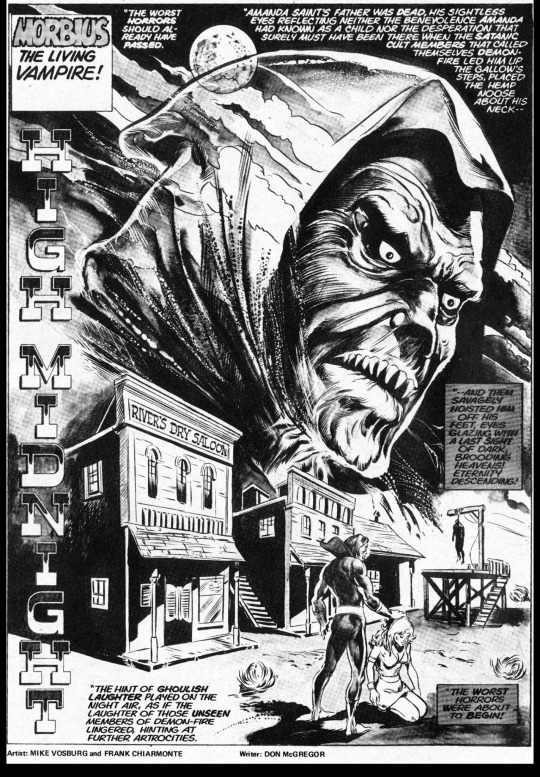
I love the moment when Morbius is taking Amanda’s dad’s body to bury it they are interrupted by Reaper and Rigor. This might be my favorite moment from this comic so far. Since it’s nighttime, Morbius has the aid of darkness so he’s able to stalk the two cult members and kill them one-by-one. He drains Rigor of his life by feeding on him. Then showing his cunning, throws Rigor’s body at Reaper so he can run up behind him and catch him off-guard. Reaper gets a pretty brutal death by falling and snapping his back on a tombstone. It was pretty awesome. Amanda when she’s by herself is almost attacked by Phineas but he’s punched by Howie and falls on a knife and dies. So after Morbius stops the cult members of Demon-Fire, their leader, Apocalypse (no not En Sabah Nur) appears to take matters into his own hands. It doesn’t really go anywhere though cause Apocalypse starts bringing demons to life and then Morbius, Howie and Amanda use dynamite to destroy the town. I loved the ending when Morbius mentions Amanda’s presence and voice to be irritating was hilarious. It was a great story and I’m glad Demon-Fire is done so now we can do something different next! Next up a Spider-Man team-up with Doctor Strange!
#marvel#marvel comics#morbius the living vampire#morbius#michael morbius#vampire tales#70’s comics#70s comics#horror comics
4 notes
·
View notes
Text
If y’all gonna be jumping in the Morbius tag because you’re thirsty for a certain cast actor at least read about the character first. Those of us in the Michael Morbius fandom (all six of us and a shoelace) would love to have some more people to talk to.
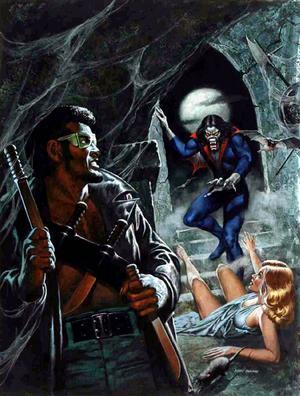
So, without further ado under the cut, my Recommendations for people who’ve never read Morb before:
Amazing Spider-man 101, 102
The first is his first appearance and the second is story resolution and backstory ala dream sequence. He was created by Gil Kane and Roy Thomas in 1971 while Stan Lee was off handling something else. They wanted to do a vampire but in Spidey’s science based world they wanted him to fit with other science-based villains. There are some articles that say he was made science-based to get around the Comics Code Authority. This is false, the comics code had already been repealed.
Vampire Tales 1-4, 5, 7, 8, 10, 11.
This is a more teen targeted black and white magazine Marvel did in the 1970′s and featured a lot of occult stories, articles, and some amazing art. This was Morb’s first set of appearances after his intro and his first played as the protagonist. When thrown back into Spidey comics he tended to go back to villain but this established him as a sometimes unorthodox anti-hero. The originals are a bit hard to get but Marvel reprinted all these as three softcover books.
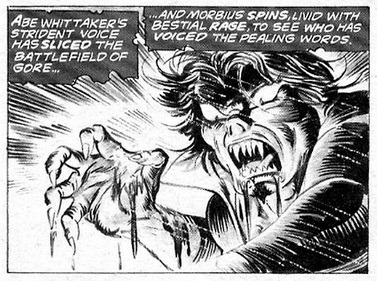
Giant Size Werewolf by Night 4
This one was an intertwining tale about he and Martine with appearances by Werewolf by night who later in the 80′s becomes a close friend of his. It’s highly recommended for both backstory and art.
Marvel Premiere 28
This is the first credited appearance of the Legion of Monsters. It’s used loosely here but later becomes an honest to god team withing the Marvel universe.
Marvel Preview 8
A double feature with Blade. This issue is notable for art by Sonny Trinidad who did a lot of art in Vampire tales. His stuff is beautiful.
Spectacular Spider-man 38 - Savage She-Hulk 11-12
The arc where he turns human again and he stays that way for most of the 80′s, fading into the background as Marvel really focused more on their heroes.
Doctor Strange Sorcerer Supreme 10,11,14-17
Here’s the arc where he becomes vampire again. It has some notable art and his first encounter with a lot of sidecast that will become lifelong friends for him.
Strange Tales Dark Corners, Blade vol1 2,3
A short story arc of Morb trying to help Martine’s family and getting caught in a fight with Blade. Unfortunately the Blade title was canned so the last thing we see is Blade and Morb fighting. It must have worked out because they’re both fine later in other issues.
Morbius the Living Vampire 1-13
His first complete title series! (he headlined Adventures into Fear for a while but I exempted it from this list for an odd convoluted plot and action that happens more around him than him actually propelling any plot forward.) It was a success at the time, going for 32 issues but honest to god the first 13 are the best as the staff changed after that. Keep in mind the 90′s were a gritty grimdark time in comics and it is RIDDLED with forced crossovers.
Marvel Zombies vol3 Marvel Zombies vol4
Each of these was four issues and full of gore so be warned. In volume four his personality is spot on and the art is fantastic!
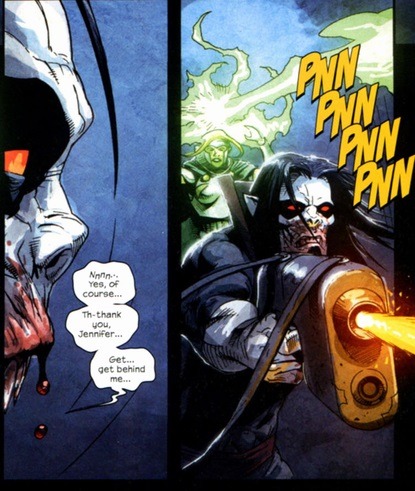
Amazing Spider-Man 679.1, 688,689,690,691
A sad arc for Morb but riddled with well written appearances and a plot to which he is integral. This led into his second solo title series which honestly crashed a bit and I’m not recommending (despite the fact I liked some of the new characters.)
Punisher 11-17 Frankencastle arc
If you love old cheesy scifi this comic was just loaded with stuff you’ll dig! Good art too and a fantastic visual style.
Legion of Monsters 1-4 mini series
Campy art and an interesting plot means this gets on the list for sure. This is also a four part story and just plain good pulpy stuff.
#Morbius The Living Vampire#Morbius#Michael Morbius#Good starter list#Obviously there's loads more#But I can't list everything#But if you have continuity questions or anything I'm always here#Or just wanna talk Morb#Just be aware when the movie comes out I'm gonna dissect it like a six graders biology project
59 notes
·
View notes
Text
Morbius Delay Should Not Affect Spider-Man 3’s Spider-Verse Story
https://ift.tt/2Y9uUud
Sony Pictures’ Spider-Man side of the Marvel Cinematic Universe has been weaving a web of sequels and spinoff projects to increasingly intricate effect. Compounding that, the apparent plot connectivity of the untitled Spider-Man 3 and Marvel Studios’ subsequent sequel, Doctor Strange in the Multiverse, seems destined to shift the shared continuity on a dimensional level. Thus questions have been raised by Sony’s latest shift for the Jared Leto-starring spinoff, Morbius, which is now on schedule for January 2022. This places the vampire film one month after the Spider-Man threequel’s December 2021 release.
The Morbius migration—the second such shift in just under a fortnight and its fourth delay overall—was a necessary retreat in the aftermath of yet another move by a bigger franchise fish in MGM’s James Bond sequel, No Time to Die, which abandoned its Easter weekend theatrical release plans for the more COVID vaccine-permeated date of Oct. 8. Nevertheless, the move could leave Morbius—a spinoff focused on the classic “Living Vampire” Spider-Man villain-turned-antihero of Marvel Comics—in a bind, since its new date of Jan. 21, 2022 puts the Spider-Man-less spinoff in the dubious position of becoming an afterthought after the possibly universe-scrambling Spider-Man 3, which is (as of press time) still holds firm on its Dec. 17, 2021 release date.
But make no mistake about it, Morbius has its own greater role to play in the grand scheme of Sony’s slow-burn plans. In fact, there appears to be a two-pronged strategy: the first goal of the new Spider-Man films is expected to focus on a continuity-shifting “Spider-Verse” storyline, possibly analogous to DC’s Crisis on Infinite Earths, where elements (and potentially castings) are reshuffled or jettisoned. That one seems set to start with Spider-Man 3, which will see Tom Holland’s wallcrawler joined by Benedict Cumberbatch’s Doctor Strange (and maybe Charlie Cox’s Daredevil), and feature a puzzling lineup of villains from past franchise iterations like Alfred Molina’s Doctor Octopus (from Sam Raimi’s Spider-Man 2,) and Jamie Foxx’s Electro (from director Marc Webb’s The Amazing Spider-Man 2).
The other prong seems to center on Sony’s long-mooted plan to build toward a team-up of villains–an anti-Avengers movie that adapts Marvel’s classic sextet of Spider-Man villains, the Sinister Six. Indeed, Morbius showcased its adherence to the latter concept over a year ago upon the release of its first trailer, which bore plentiful Spider-Man teases.
The vampire film, in a manner akin to 2018’s Venom (whose sequel, Venom: Let There Be Carnage, is still set to arrive this June) will introduce Leto’s Michael Morbius, a scientist suffering from a rare blood disease. In his desperation, Michael concocts a radical cure that grants him superhuman abilities, albeit with the cruel caveat of being forced to mollify an insatiable thirst for blood. Hence how the character—created by writer Roy Thomas and artist Gil Kane—becomes a “living” vampire. This also means he’s not technically an undead creature like the fang-bearers of conventional lore.
Read more
Movies
Is Spider-Man 3 a Spider-Verse Sinister Six Movie?
By Jim Dandy
Movies
Morbius: An Introduction to the Spider-Man Spinoff Movie Character
By Rob Leane
After being introduced in the pages of The Amazing Spider-Man back in 1971 as a villain, the character gained popularity due to his portrayal as a tragic figure, and, by the early 1990s, became a full-blown antihero and member of team-ups from the Midnight Sons to even SHIELD itself. There is 50 years’ worth of potent Marvel material to adapt in order to expand Morbius’ role in the MCU-adjacent Sony Spider-Man corner.
Yet while the cold introduction treatment of Morbius in his own film might bear similarity to the release of Venom, Morbius‘ trailer implies that the MCU Spider-Man connections will be far more prevalent this time around. Firstly, the clip includes a scene (pictured below,) showing Leto’s Morbius walking in a dirty back alley—noticeably in covered-up prison garb, indicating he’d just escaped—while passing a poster of Spider-Man graffitied with the message “murderer,” which firmly places the film’s setting after the events of 2019’s Spider-Man: Far from Home, in which a mid-credits scene shows Jake Gyllenhaal’s Mysterio posthumously getting revenge on Spidey by outing him as Peter Parker, and framing him for his murder.
But the trailer’s real kicker is its cameo from Michael Keaton, who is seen reprising his antagonist role from 2017’s Spider-Man: Homecoming as Adrian Toomes/the Vulture, clearly codifying the spinoff’s place in the wider continuity.
Therefore Morbius seems likely to become a key early component of Sony’s long-term Sinister Six designs; a stratagem that the studio can feasibly implement concurrently with its apparent continuity-crossing storyline—speculated for Spider-Man 3 and Doctor Strange in the Multiverse of Madness. That would leave the smaller-scope movie, Morbius, awkwardly in the middle of the two presumed Spider-Verse offerings. Yet it’s not an unprecedented position since the 2018 MCU sequel Ant-Man and the Wasp similarly found itself scheduled between the monumental, Thanos-snap-centric events of 2018’s Avengers: Infinity War and 2019’s Avengers: Endgame.
Additionally, Sony’s desire to get the higher profile Spider-Man 3 in theaters in time for a Christmas release—particularly with the film apparently being set at Christmas—would likely supersede any concerns of continuity, presuming some degree of vaccinated normalcy is achieved in the next 11 months.
Consequently, should the current release dates hold (which, in all honesty, is a tenuous proposition), then Morbius’ shift to Jan. 22, 2022 shouldn’t (emphasis on “shouldn’t”) have a negative effect on the speculated Spider-Verse movies between which it has been sandwiched on the schedule. While we’re still a long way from Sony’s Sinister Six, the film’s inclusion of Vulture is telling, since he’s a founding member of the rogues team, and a key presence in its various lineups throughout the decades. It’s an aspect that could lend Morbius the same kind of auspicious energy that Samuel L. Jackson’s debuting Nick Fury brought to the MCU-launching Iron Man’s mid-credits scene, in which he teased “the Avenger initiative” and “a bigger universe.” – That, of course, proved to be one of the biggest understatements in cinema history.
Subscribe to Den of Geek magazine for FREE right here!
(function() { var qs,js,q,s,d=document, gi=d.getElementById, ce=d.createElement, gt=d.getElementsByTagName, id="typef_orm", b="https://embed.typeform.com/"; if(!gi.call(d,id)) { js=ce.call(d,"script"); js.id=id; js.src=b+"embed.js"; q=gt.call(d,"script")[0]; q.parentNode.insertBefore(js,q) } })() cnx.cmd.push(function() { cnx({ playerId: "106e33c0-3911-473c-b599-b1426db57530", }).render("0270c398a82f44f49c23c16122516796"); });
The post Morbius Delay Should Not Affect Spider-Man 3’s Spider-Verse Story appeared first on Den of Geek.
from Den of Geek https://ift.tt/3pfAXcA
0 notes
Text
The Rise, Fall, and Rebirth of Horror Comics: A Basic History
In the Beginning
Depending on who you ask, the answer may vary on the origin of horror comics. Mike Howlett, a horror comics history scholar, would tell you to look back to December 1940 for the comic based on Mary Shelley’s Frankenstein. This story was published in “The New Adventures of Frankenstein” from Prize Comics #7. Individual horror comics could possibly trace their origins to the comic adaptation of Robert Louis Stevenson’s Strange Case of Dr. Jekyll and Mr. Hyde appearing in Gilberton Publications’ Classic Comics #13 in August 1943.
Looking back even further, DC Comics decided to get in on the fun with Dr. Occult in the 1930s. Eerie (1947) from Avon Publications is championed as the first horror comic series with original content. However, it is Adventures into the Unknown (American Comics Group) that claims the title of the first horror comics title since 1948.
From then on, the genre continued to spread and evolve with mixed reception.
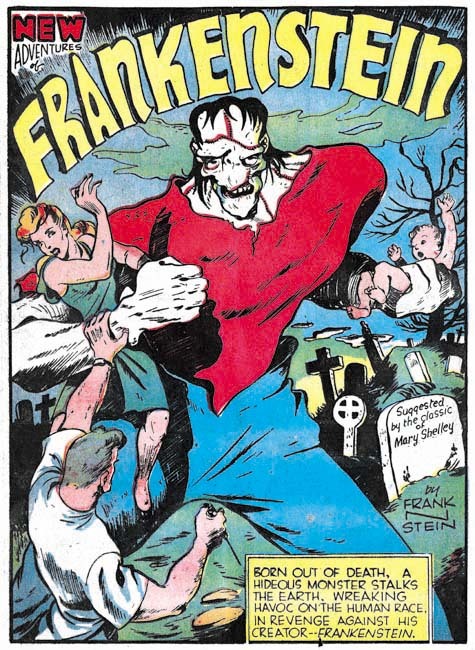
Yet horror comics began to expand. Many tropes of today can be found in these popular stories. They began to include terrible villains, bloodshed, monsters, scanty damsels in distress, torture and more.
Gilberton, Dell Comics, Gold Key Comics, Warren Publishing, and many others filled the spaces of horror than fans needed. Fawcett, Youthful Magazines, Harvey Comics, Charlton. The list goes on and on.
Readers became more exposed to these treacherous tales thank to a sudden boom in the genre. About 1950, comics saw the great birth of horror from EC Comics! Famed as one of the most influential in the horror game, fans today still speak their praises. Censorship in the 1950’s pushed EC a bit off track, but it didn’t stay for long. Some great tales from its day can now be found in reprints, but you can always look deeper into seller sites for the real deal. EC Comics was often imitated but never duplicated.
Some of your favorite publishers got caught up in the wave too, creating such titles like Journey into Mystery, House of Mystery, and Strange Tales. Our favorite superheroes may not have existed if not for this great explosion. What a thought!
Enter: Dr. Fredric Wertham!
You all knew this was coming. In 1954, comics all over were hit when Dr. Wertham published Seduction of the Innocent. Comics all over were hit with, regulations and policies and near censorship. Crime and horror comics were seemingly choked, and some were laid to rest altogether. Pretty soon your favorite titles had that big CCA on the cover. Not all books felt the same effects as others, though.
Crime and horror had to be set straight. The heroes must be distinguishable from the villains. No bloodshed or mangled bodies after a fight. The heroes must always win! Sounds pretty lame, right? Not everyone wants a happy ending.
The comic book media was determined to keep moving forward. Even through failed titles and “implosions”, the mainstream publishers grew. Wertham couldn’t keep his claws in our books forever
Not Dead Yet
Not even the off base “studies” of an out of touch psychiatrist could hold its grip on horror comics. Lots of publishers began to fill in the void. There was no stopping this hype train.
In 1962, Dell Comics published Ghost Stories to kick off it horror line. 1966 saw the birth of Charlton horror comics with Ghostly Tales. The blood-sucking seductress Vampirella made her debut in 1969.
In the late 1960s and early 1970s, Marvel dipped its hand into the game. They began putting out titles like Tower of Shadows, Chamber of Darkness, Where Monsters Dwell, Where Creatures Roam, The Fear, and others. Some of these publications dropped of or were simply reprints of old stories, but the ripple effect is still felt .Comic titles Werewolf By Night, Tomb of Dracula, and other classic horror tales sprung up. During this time, we see the emergence of fan favorites Morbius, Man-Thing, Blade, and more.
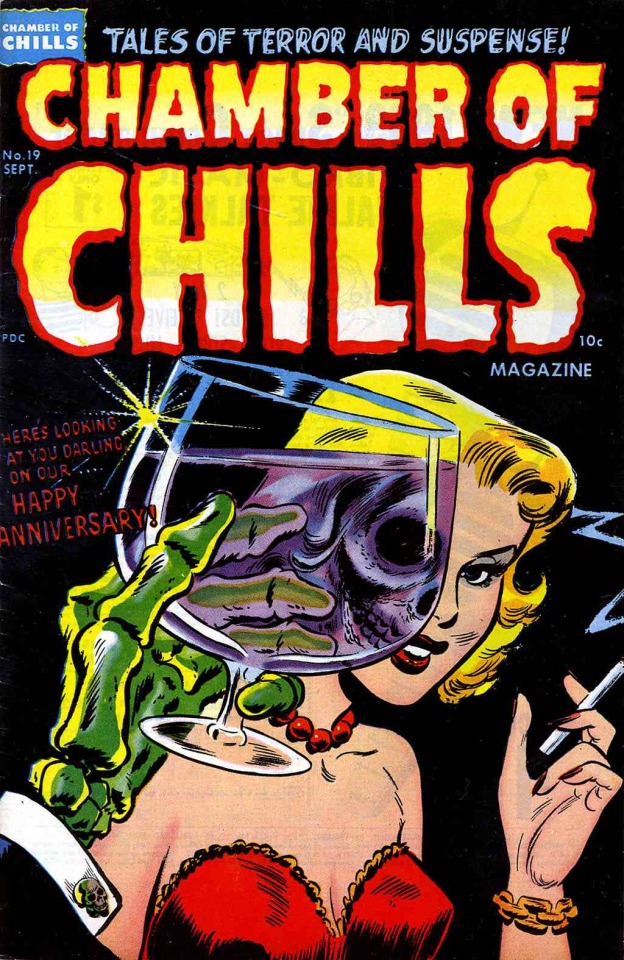
Many of these characters may be featured in more modern stories or crossing over with your favorite web-slinger or such.
DC Comics got in on this too. Stories like The Unexpected, House of Mystery, Secrets of Haunted House, and more popped up and sometimes spurned spinoffs for readers to enjoy. The Modern Age saw fit to carry on some horror titles as well. DC Comics imprint, Vertigo, also threw its hat in the game with Hellblazer, Preacher, and others like it. Swamp Thing, John Constantine, and Elvira were just a small few of the characters of horror that have stayed fan faves for years.
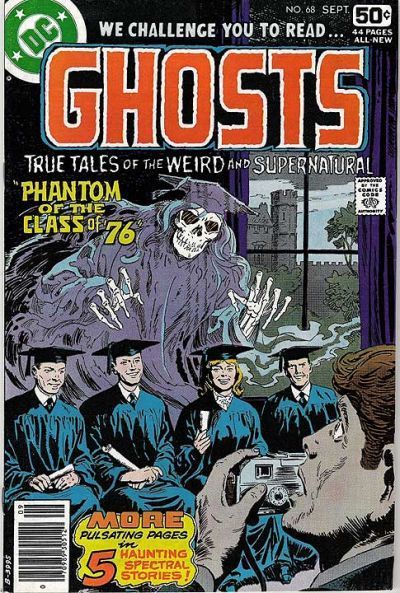
This doesn’t begin to cover the horror titles that come out from other parts of the world. Many countries published many of their own comics. Some have more classic characters and stories than others. Mexico, India, Japan, Korea, and many countries all over the world staked their claim in the game. Many of them stand on their own. I haven’t read these books, but I’m sure they’re good reads. As interesting as they seem, I’m only one person with so much time on her hands. I would certainly say that if you are looking for something more mature, definitely check out non-American books.
Disclaimer: Some of these titles are more adult than others. We are not responsible if you got caught reading dirty books.
Modern Horror
In the last two or so decades, indie comics and publishers have been on the rise. You can still find a few horror comics from your favorite big names. However, the amount of books available is exciting and can be daunting to some. I say, there are no wrong ways to go about your horror comics hunt. Everybody’s getting in on the horror comics.
In the information age, he only thing stopping you from bloodcurdling books is a bad Wi-Fi connection. Archie, Revival, Sabrina the Teenage Witch, Jughead, iZombie, Hellblazer, Preacher are a drop in the bucket of horrific content. You could have it all! Please do not read this as Outright Geekery being in support of illegally obtaining comics.
DC Comics, Vertigo, Image Comics, Aftershock Comics. I could sit here all day pointing fingers in different directions.
So What’s the Big Deal?
Why are people so interested in the horror game, you may ask. Well, why shouldn’t we be. People have been obsessed with things that go bump in the night for as long as stories have been told. Whether you want a rush or to satisfy some dark fantasies, there’s something for everyone. There’s gotta be a dark spot to counter all that truth, justice, and American way, right?
Personally, I love good scare. The dark, and morbid nature of humans is brought to light in these fantastical tales. That, is an interesting thing to see. Combine that with the spooky voice of the writer, the compelling and supernatural pencil of the artist, and the attraction and relatability of the characters. Just look at those covers! How can you sit there and say you don’t want to rip those open and give them a read?
The human mind is complex thing. What better way to poke and prod at a man’s subconscious than to bring out his worst nightmare? What better way to poke and prod at our own psyche than to want to read such stories?
Itching for more spine-tingling and flesh-crawling stories? Check out your local comic shop or visit the website of your favorite publisher for more. Now, go get your spook on!
#horror#horror comics#dc comics#marvel comics#ec comics#gilberton#charlton comics#vertigo comics#image comics#aftershock comics#dell comics#gold key comics#avon publishing#frankenstein#monsters
3 notes
·
View notes
Text
Blade: The Evolution of Marvel's Vampire Hunter
https://ift.tt/340bjgZ
An obscure comic hero became a founding father to the age of good Marvel comics movies and will be making his cinematic return soon enough.
facebook
twitter
tumblr
Blade finally coming to the Marvel Cinematic Universe (played by Mahershala Ali) is a little different from the other comic characters in rebooted movies. Unlike, say, Spider-Man or Joker, Blade comes with a certain set of expectations that have less to do with his comic book origins, and more to do with the Wesley Snipes movies. Sure, there’s going to be the novelty of being in a shared universe, but a lot of Blade’s popularity comes from the previous movies and it's been long enough since Blade Trinity that they can reboot the series and still keep it feeling familiar.
Even though he debuted in the 1970s, Blade was never a major player in the comics. He more or less was transformed into Snipes’ depiction of the character after the initial movie’s success. That said, even though his initial appearance in Tomb of Dracula #10 was so different from what eventually arrived on screen, Blade gradually evolved across supporting roles, backup stories, guest appearances, and obscure starring roles.
We start with Tomb of Dracula, a comic series that went on for 70 issues. For a time, Marvel was at the mercy of the Comics Code Authority, whose self-censorship rules were often ridiculous. By 1971, they started to loosen the reins on some of their sillier edicts, such as, “No vampires ever!” Marvel took to this news by introducing two major characters to their universe: Morbius the Living Vampire (who is to regular vampires what 28 Days Later infected are to zombies) and Dracula.
Tomb of Dracula was like the antithesis of a superhero comic. It was more like the monthly version of a horror movie series. Think of it like the Nightmare on Elm Street franchise. Every installment was about the evil monster and although he’d be thwarted, he’d never be taken off the board for long. Freddy wasn’t the protagonist of any given story, but he was also way more interesting than anyone who was. In other words, it was the monthly adventures of Dracula, constantly getting opposed by a variety of vampire hunters, but they could never seem to finish him off for good.
Blade was introduced in Tomb of Dracula #10, created by Marv Wolfman and Gene Colan. The opening scene featured him rescuing a couple of would-be victims from a vampire attack. To point out how ice cold he was compared to other vampire hunters, elderly protagonist Quincy Harker (the Dr. Loomis to Dracula’s Michael Myers) showed up to point out that those vampires were mere teenagers while Blade shrugged it off. He then went on to fight Dracula on a cruise ship.
Most recall Blade’s original appearance, with his green jacket and yellow goggles. This initial take on the character was depicted as just a human being instead of the famed “Daywalker,” and specialized in wielding wooden knives. Sure, he could have just used silver knives for the same level of lethality, but wooden knives was a creative enough gimmick.
read more: Dracula vs. The Marvel Universe!
He eventually got roped into joining Harker’s band of vampire killers. If Harker was the anti-Dracula version of Professor Xavier, then Blade was easily the Wolverine of the team. He was the gruff, outspoken, reckless badass. Granted, he didn’t have any superhuman abilities at the time, so Dracula tended to toss him around like a rag doll. Still, Blade did succeed in carving up Drac’s face one time and managed to (temporarily) kill him with a wooden knife to the chest.
Just prior to killing Dracula, Blade finally opened up to his compatriots about why he had such a hate-on for vampires. When Blade’s mother was in labor with him, the doctor arrived and told her friends to leave them be. Turned out he was Dracula (Dr. Acula?) and he started feasting on Blade’s mother. The other women ran in to ward him off and at least save the baby. Blade grew up wanting revenge on Dracula and vampires in general.
It didn’t take long for them to alter his origin. When Blade appeared in the more risqué black-and-white Marvel horror magazines from around that time, they were more forward about his mother being a prostitute and how Blade was raised in a brothel. They also changed it so that Blade’s mother was killed by the vampire Deacon Frost. Despite the retcon, writers and editors could never keep it straight and even into the '90s, some stories had Blade credit Dracula to his mother’s death.
read more: Marvel Cinematic Universe: The New Characters of MCU Phase 4
As a way of giving Blade reason to personally hate both vampire villains, a story in Marvel Preview #3 had him reflect on a drug-addicted jazz trumpeter named Jamal Afari, who acted as a father figure to young Blade and taught him how to kill vampires. Afari was eventually turned by Dracula, meaning Blade had to take him out in a mercy killing. Ergo, Blade wanted Dracula AND Deacon Frost dead.
While Blade’s appearances were mostly relegated to the pages of Tomb of Dracula and whatever black-and-white monster comic Marvel had going on, he made his first crossover into the larger Marvel continuity in the pages of Fear #24. There, he fought against Morbius the Living Vampire. You would think that Blade vs. Morbius would be the easiest setup possible.
So of course, the story begins with Morbius in space, helping a one-eyed creature in a cape escape a bunch of space barbarians. By the time Morbius returned to Earth, Blade figured him to be an alien vampire and Morbius thought Blade to be a madman because – as far as Morbius was aware – vampires didn’t exist unless they were the science-built kind like himself. Blade realized Morbius wasn’t an alien because he could speak English, but that kind of ignores how all the aliens in the same issue were also speaking English.
Anyway, the comic was weird.
With Blade having temporarily killed Dracula, it was time for the turnabout. A rematch had Dracula not only overwhelm Blade, but he chomped down on his neck and left him for dead. Harker arrived later, horrified at the sight of Blade with fang marks in his neck and went to finish him off before it was too late. Blade instead stopped him, stood up, and dusted himself off. He was strangely fine.
The big reveal was that due to the very specific circumstances of his birth, Blade was immune to vampirism. He was still a human and didn’t have any cool special abilities, but he couldn’t be turned. It made him a half-baked version of the character we know and it only came up a few times anyway, usually allowing him to lose against vampires and then play possum as one of their own.
read more: 13 Essential Horror Comics
If anyone was going to get the best of Dracula enough to end the series, it was going to be Harker. Blade still remained a regular part of Tomb of Dracula and ended up finding a couple of lasting allies. Frank Drake was the human descendant of Dracula who chose to combat his evil ancestor. Then there was Hannibal King, a reluctant vampire who acted as a detective. You might remember him from Blade Trinity, where Ryan Reynolds used him as an audition to play Deadpool. Or not, since he didn’t really have many similarities to the comic version of King outside of killing vampires alongside Blade.
Blade and King ended up taking on Deacon Frost together and joked after the fact about how they made for a good team despite their The Fox and the Hound dynamic.
Once Tomb of Dracula ended and all the black-and-white horror comics dried up, the '80s kicked in and Blade did a whole lot of nothing. He, Drake, and King made a few appearances in Doctor Strange, as Strange was in the midst of taking on Dracula. Strange succeeded in pulling off a spell that caused a full-on vampire genocide, which not only annihilated Dracula, but also cured King of his affliction and turned him fully human again. Without vampires to go after, Blade and friends just became a detective agency and fell further into obscurity.
read more: The Behind the Scenes Problems with Blade Trinity
Tomb of Dracula returned in the early '90s as a miniseries, bringing vampires back into the Marvel fold. Blade still had his '70s look going on here for one last hurrah. This time around, they made him seem a bit more unhinged and obsessed with killing Dracula. Really, it was no more obsessed than usual, but they did throw him into an asylum by the end of the series, so dick move to Drake and King.
Months later, we got our first look at the modernized take of Blade. Not in a storyline or anything like that, but a pinup in the back of Ghost Rider #25. This was part of the hype for a new series being born out of the pages of Ghost Rider called Nightstalkers. Blade, Drake, and King would finally be getting their own series, only it was overflowingly 90s. For one, Nightstalkers #1 was “Part 5 of 6” for the storyline “Rise of the Midnight Sons.”
read more: The Weird History of Marvel Superheroes vs Monsters
Hannibal King, a vampire again, had wild Saiyan hair, red eyes, and claws. Frank Drake looked like any given Liefeld X-Men character of the time, donning a ponytail, giant cyber rifle, and targeting headset. Blade himself had a leather jacket, flat top, and katanas. He’s the one who came out of this looking good.
Coincidentally, this is right around when Marvel started development of the movie.
Nightstalkers lasted eighteen issues and while that was going on, an anthology series called Midnight Sons Unlimited dedicated itself to the adventures of macabre-based heroes like Blade’s crew, Morbius, and Ghost Rider. Nightstalkers came to an end with a final issue that seemingly killed off both Drake and King. Granted, they’d each resurface one way or another over time, but this was a way to let Blade go solo.
read more: Doctor Strange Comics Reading Order
Blade: The Vampire-Hunter lasted ten issues. A couple of years later, they released a few one-shots and a miniseries to get a little hype in for the new movie. Blade hit theaters on August 21, 1998. A commercial success, it finally made him a part of Marvel worth remembering for those who weren’t the most hardcore of readers (keep that in mind when you find yourself wondering why Eternals is going to happen). Naturally, this meant that the comic version of the character needed to reflect his cinematic counterpart.
Now, interestingly enough, this meant nothing when it came to Abraham Whistler. Outside of adaptations of the films, Whistler has been missing from the comics. And sure, that’s not the biggest deal. It’s not like Bob the Goon started popping up in Detective Comics after Tim Burton's Batman movie in 1989. What’s kind of crazy is that despite Blade being a 1998 release, Abraham Whistler’s very first screen appearance is in a 1995 episode of Spider-Man: The Animated Series!
Hey, Marvel’s crazy promotional foresight goes way back.
Animated Blade also first introduced the idea that he had vampire powers without the weaknesses. Since, “A vampire slaughtered my prostitute mother while I was born,” wouldn’t exactly fly on a cartoon where Spider-Man isn't allowed to punch Dr. Octopus, they just went with the origin that Blade’s dad was a vampire and his mother was human. If it was that easy, you’d think there would be more like him.
read more: 13 Essential Dracula Performances
Again, the comics version of Blade was just a very fit guy with an immunity. They obviously wanted to upgrade him a bit and so they did...but only a little. In the pages of Peter Parker: Spider-Man, during the chaotic Howard Mackie/John Romita Jr. run where a lot of stuff was happening but none of it mattered, Morbius was experimented on and set loose on the Kingpin. Blade and Spider-Man got involved and during the fracas, Morbius bit Blade in the arm.
It was treated as barely a thing in the comic and Blade just walked it off without making any reference to it, but they used that minor moment to later explain that Blade being bitten by THE LIVING VAMPIRE had a very different reaction to his biology and gave him vampire powers. So that’s how that happened.
In 2002, Blade got a MAX-rated series by Christopher Hinz and Steve Pugh that played up his cinematic depiction. Then in 2006, Marc Guggenheim got a 12-issue Blade ongoing that played up his connection to the greater Marvel Universe by having him cross paths with Spider-Man, Wolverine, and Dr. Doom. Since then, he’s shown up here and there, even becoming a surprise member of the Avengers at one point.
read more: An Underworld/Blade Crossover Almost Happened
But before I end this, I have to talk about the last comic before they decided to go all-in on the Snipes Blade design. Based on the movie’s success, there was a Blade run by Bart Sears that came out late-1999 into early-2000. Now, everyone talks shit about everything that comes with the 1970s look, but considering what Blade was wearing in 2000...?
We owe him an apology.
Gavin Jasper writes for Den of Geek and always liked that issue of Marvel Team-Up where Blade and Punisher hung out on a rooftop, watching a deal between mobsters and vampires go down in the alley below. Read more of Gavin’s articles here and follow him on Twitter @Gavin4L
Read and download the Den of Geek NYCC 2019 Special Edition Magazine right here!
facebook
twitter
tumblr
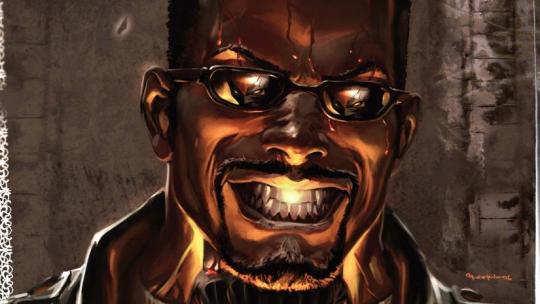
Feature Gavin Jasper
Oct 25, 2019
Marvel
Blade
from Books https://ift.tt/2Plpl8L
0 notes